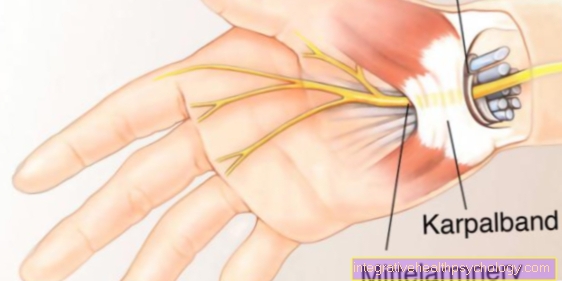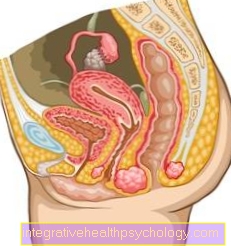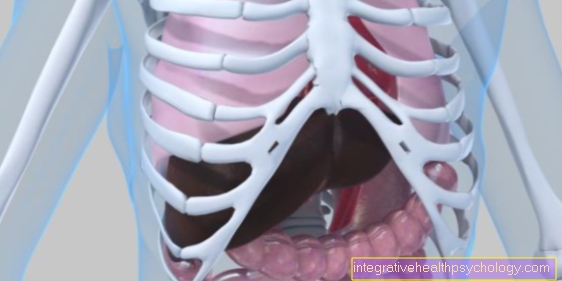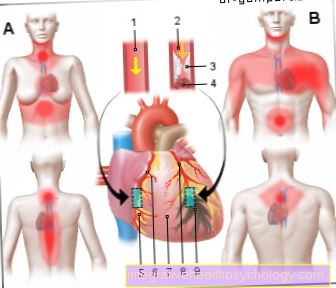Can a tingling sensation indicate a circulatory disorder?

introduction
Circulatory disorders lead to an undersupply of the tissue with blood and nutrients. The cause can be both arterial and venous vessels. Circulatory disorders can cause abnormal sensations such as tingling. Other typical symptoms are pale skin and headaches.
As a rule, circulatory disorders and the associated symptoms develop slowly. However, there are other causes for a tingling sensation. An important differential diagnosis is ailments to the nerves. Nerve diseases typically also lead to abnormal sensations such as tingling.
Tingling in the feet or hands
A tingling sensation in the feet / toes or tingling in the hands / fingers may indicate a circulatory problem. A tingling sensation in the fingers or in the toes after spending a long time in the cold and then warmth flowing back in is normal. This process is more pronounced in Raynaud's syndrome. Stress or cold causes the fingers to fade and then turn blue. After a while, there is reactive blood flow, i.e. reddening of the fingers. Raynaud's syndrome is often associated with other systemic diseases.
In addition to circulatory disorders, symptoms in the nerves can lead to a tingling sensation - such as Nerve entrapment or polyneuropathy. These are more common than circulatory disorders. A tingling sensation can also result from poisoning or psychological causes.
However, since there are many possible causes, a detailed clarification with the family doctor may also need to be carried out by a neurologist. A physical examination, imaging experience and measurements of the nerve conduction velocities can successfully differentiate the cause.
Read more on the topic: Circulatory disorders of the hands
Tingling in the legs
A classic circulatory disorder is PAD (peripheral arterial occlusive disease). In this disease, the arterial vessels become blocked. Usually the arteries of the legs are affected. In the context of these diseases, abnormal sensations such as tingling may occur.
Read more on the topic: Burning in the legs
More typical of PAD in an advanced stage, however, are load-dependent, cramp-like pain in the legs. PAD is a chronic disease. Acute circulatory disorders in the legs are usually not accompanied by tingling sensations or other complaints, such as severe pain, are in the foreground.
There are a number of other causes of tingling in the legs that are not caused by a circulatory disorder and occur very frequently. Polyneuropathy typically results in a tingling sensation in the legs, especially the feet. Other abnormal sensations can also occur. In a polyneuropathy, the nerves are restricted in their function. The causes for this are very diverse: diabetes mellitus, alcohol consumption, .... But also with other diseases that affect the nerves, abnormal sensations can occur in the legs, e.g. if you have a herniated disc or nerve entrapment.
Find out more about the topic here: PAOD.
Tingling in the face
A tingling sensation in the face is not typical of a circulatory disorder. Damage to the facial nerves is often the cause of a tingling sensation or pain.
Burns and frostbite can also lead to such abnormal sensations. Multiple sclerosis can be less common. Another rare cause of abnormal sensations in the face can be a tumor.
Tingling in the head
A tingling sensation in the head can be an indication of a circulatory disorder in the context of a stroke. In the case of a stroke, there is an insufficient supply of an area of the brain. The cause of this is an arterial obstruction or, less often, a bleeding. Characteristically there is a sudden onset of symptoms.
Furthermore, a tingling sensation in the head or face can herald a migraine attack. In rare cases, a tumor is the possible cause.
Read more about the topic here: Migraine.
The differential diagnoses
The carpal tunnel syndrome
In carpal tunnel syndrome, pain and other abnormal sensations, such as tingling, typically occur in the affected hand. The cause is an entrapment of the median nerve. This pulls on the inside of the knuckles through the so-called carpal tunnel. Because of the tightness of this canal, it is easy to pinch the nerve.
At first, the pain typically occurs at night in the middle and index fingers. If it persists for a long time, there is also a decrease in the muscles at the ball of the thumb.A common cause of carpal tunnel syndrome is overload.
More information on the topic Carpal tunnel syndrome you'll find here.
The tarsal tunnel syndrome
The tarsal tunnel syndrome is basically the same as the carpal tunnel syndrome. Only the foot is affected here instead of the hand. The tibial nerve, which supplies the foot, runs below the inner ankle through the tarsal tunnel. This forms a bottleneck for the nerve, which can lead to nerve compression. This again leads to pain and discomfort in the foot.
Although tarsal tunnel syndrome is not as common as carpal tunnel syndrome, there are a variety of causes. On the one hand, footwear that is too tight can trigger the symptoms, but trauma to the foot, arthritis and other things can also be the cause.
Read more about the topic here: Tarsal tunnel syndrome.
Herniated disc of the lumbar spine
A herniated disc causes the inner core of the disc to rupture, putting pressure on the nerve that emerges from the spinal cord at this level. The complaints that result from this can be very diverse.
Initially, abnormal sensations such as tingling or numbness can arise in the area affected by the nerve. In severe cases, paralysis in the leg is also possible. There is also pain of a stabbing, shooting character. If necessary, reflexes can also fail.
Symptoms of a herniated disc of the lumbar spine - Find out more about this topic here.
multiple sclerosis
In multiple sclerosis, inflammation of the myelin in the central nervous system occurs again and again, which surrounds the nerves like a covering layer. The inflammation leads to a breakdown of the myelin and consequently to a restriction of the nerves. After the inflammation subsides, the nerve damage may persist.
The symptoms depend on which nerves are affected. Among other things, abnormal sensations, tingling and numbness are possible in all parts of the body. The optic nerve is often affected as the first manifestation, so that at times there is a deterioration in vision. Usually it occurs in adults in young adulthood. MS should be considered if nerve damage repeatedly occurs in different parts of the body.
More information on the topic multiple sclerosis get here.
The spinal stenosis
Spinal canal stenosis is a narrowing of a nerve shortly after it pulls out of the spinal cord through the spinal canal. The entrapment causes symptoms similar to those of a herniated disc.
However, movement-dependent pain that pulls into the leg is typical. Spinal canal stenoses result from back malformations / postures, injuries to the spine or signs of wear and tear.
TIA
TIA stands for transient ischemic attack. As with a stroke, there is an insufficient supply of a certain brain area. By definition, however, the symptoms disappear within an hour.
Depending on the brain area, the symptoms are very different. Parasitic sensations in the face or head are possible. Even if symptoms go away within an hour with a TIA, a doctor should be examined. Because the risk of stroke after a TIA is significantly increased.





























